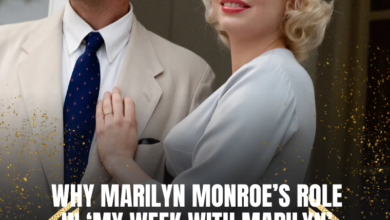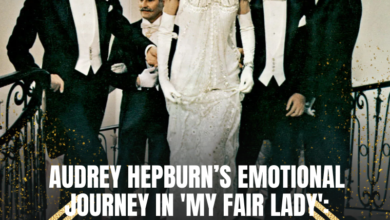Wes Anderson Reveals the Marilyn Monroe Movies That Shaped His Unique Cinematic Style
OPINION: This article may contain commentary which reflects the author's opinion.
Wes Anderson’s films are known for their meticulously crafted visual style, eccentric characters, and intricate storylines that feel like surreal works of art. His recent feature Asteroid City continues this tradition, blending futuristic elements with the timeless charm of old Hollywood. While the film explores strange occurrences in a desert town, Anderson’s admiration for Marilyn Monroe—an icon of the golden age of cinema—shines through, especially in his portrayal of Scarlett Johansson’s character, Midge Campbell.
In an interview discussing Asteroid City, Anderson shared his deep respect for Monroe, noting how her vulnerability influenced Johansson’s portrayal of Midge. “She’s this most vulnerable kind of talent where there’s something real happening in front of the camera,” Anderson explained. “She’s a movie actress who goes back the other way. I don’t know that she ever played on the New York stage, but she went into the Actors Studio and tried to dig deep in that way.”
Monroe’s career, marked by dazzling beauty and talent, was also fraught with personal struggles, and her tragic death has often overshadowed her on-screen achievements. Yet, Anderson emphasizes the power of Monroe’s vulnerability, something that resonates deeply in his own films, where characters often grapple with deep emotions in a world full of eccentricities. He sees this quality in Johansson’s performance in Asteroid City, where Midge embodies a character trapped in a constant state of melancholia and uncertainty, echoing the complexities of Monroe’s on-screen presence.
The Influence of Monroe’s Iconic Performances
Marilyn Monroe is a symbol of old Hollywood, a star whose presence dominated the screen, captivating audiences around the world. Known for roles in classics like Some Like It Hot, Gentlemen Prefer Blondes, and All About Eve, Monroe’s talent defined an era of filmmaking. Yet, as Anderson highlights, she was more than just a glamorous figure; she was a deeply vulnerable and introspective actor, which makes her stand out even today.
When asked about his favorite Monroe films, Anderson revealed his admiration for two of her standout performances. “I love her in Some Like It Hot and The Prince and the Showgirl,” Anderson shared. “Billy Wilder made two movies with her, and he knew there was just no other way to get Marilyn Monroe than to go through the whole thing, to have Paula Strasberg telling her what to do behind his back.”
In these films, Monroe’s blend of comedy, vulnerability, and depth was fully realized, and Anderson acknowledges the skill required to capture that essence. Monroe’s performances were often marked by an extraordinary balance of lightness and depth, and in her, Anderson sees a kindred spirit: an artist who was deeply human, despite the glitz and glamour surrounding her.
Asteroid City and the Legacy of Monroe
In Asteroid City, Anderson explores themes of grief, community, and the human condition in a way that feels remarkably modern, even though the film is set in 1955. Monroe’s influence on Johansson’s character is evident in Midge’s emotional depth, which reflects Anderson’s fascination with characters who are searching for meaning in a chaotic world. Johansson, like Monroe, brings a raw vulnerability to her role, capturing the essence of a woman caught between external expectations and inner turmoil.
The reference to Monroe in Asteroid City is more than just an homage to a Hollywood icon. It serves as a reminder of the complexity behind the glitz and glamour, echoing Anderson’s own cinematic style, which often delves into the intricacies of human emotions. As Monroe’s legacy continues to inspire filmmakers, Anderson’s unique vision blends the past and present, creating a film that honors the past while pushing the boundaries of contemporary storytelling.
Anderson’s Unique Vision: An Alien in a Strange System
While it might seem surprising that someone with Anderson’s highly individualistic style would cite Monroe as an influence, the director’s admiration for her authenticity aligns with his own approach to filmmaking. Anderson, much like the alien character voiced by Jeff Goldblum in Asteroid City, operates within a strange cinematic system, speaking a language all his own. The alien’s otherworldliness in Asteroid City can be seen as a reflection of Anderson’s own position in the film industry—an outsider communicating through a singular, idiosyncratic lens.
Much like Monroe’s struggle to be understood in a world that constantly tried to define her, Anderson’s work often feels like an attempt to carve out space for an alternative voice, one that speaks directly to the heart of human experience. Monroe’s vulnerability, as Anderson points out, is at the heart of what makes her performances resonate—something that has clearly influenced his own work.
Conclusion: Monroe’s Legacy Lives On
Marilyn Monroe’s legacy continues to inspire, not just for her beauty and iconic status, but for the vulnerability she brought to the screen. Wes Anderson’s admiration for Monroe’s work in Asteroid City reveals a deep connection between the past and present, between Hollywood’s golden age and contemporary cinema. As Anderson’s work continues to evolve, the influence of Monroe’s authenticity, vulnerability, and emotional depth remains a cornerstone of his own storytelling. Whether in the midst of chaos or amidst calm, Monroe’s spirit continues to shape the way we view cinema and the human experience.



